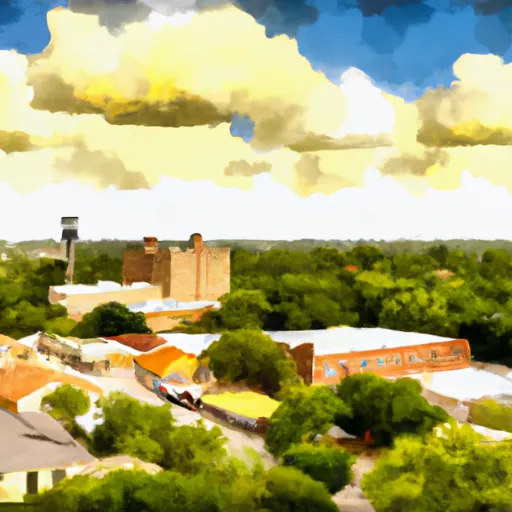-
 Snoflo Premium
Snoflo Premium
Get unlimited access to all our content
With no Ad interruptions! - Start Your Free Trial Login with existing account
Sabinal
Eden Index
Climate
7.8
•
Recreation
•
Community
2.3
•
Safeguard
3.7/10

Sabinal is a small town located in Uvalde County, Texas. With a population of around 1,800 people, it offers a peaceful and close-knit community atmosphere. The climate in Sabinal is characterized as humid subtropical, with hot summers and mild winters. Summers are typically hot and dry, with temperatures often exceeding 90°F, while winters are mild with average temperatures ranging from 40°F to 60°F.
Hydrologically, Sabinal lies in the Sabinal River watershed, which is a tributary of the Frio River. The Sabinal River provides opportunities for water-based activities such as swimming, fishing, and kayaking. The area is known for its crystal-clear waters and scenic beauty.
Outdoor recreation opportunities in Sabinal are abundant. The town is surrounded by picturesque hills and valleys, making it an ideal location for activities like hiking and camping. Sabinal Canyon offers stunning views and opportunities for birdwatching and wildlife spotting. The nearby Garner State Park is a popular destination for camping, hiking, and tubing along the Frio River. Additionally, there are several hunting ranches in the area, attracting hunters seeking game such as deer and wild turkey.
In summary, Sabinal, Texas, offers a pleasant climate, hydrological attractions, and a variety of outdoor recreational opportunities, making it an enticing destination for nature enthusiasts and those seeking a tranquil small-town experience.
What is the Eden Index?
The Snoflo Eden Index serves as a comprehensive rating system for regions, evaluating their desirability through a holistic assessment of climate health, outdoor recreation opportunities, and natural disaster risk, acknowledging the profound impact of these factors on livability and well-being.
Climate Health Indicator (CHI): 7.8
Sabinal receives approximately
643mm of rain per year,
with humidity levels near 83%
and air temperatures averaging around
21°C.
Sabinal has a plant hardyness factor of
8, meaning
plants and agriculture in this region tend to thrive here all year round.
By considering the ideal temperature range, reliable water supplies, clean air, and stable seasonal rain or snowpacks, the Climate Health Indicator (CHI) underscores the significance of a healthy climate as the foundation for quality living.
A healthy climate is paramount for ensuring a high quality of life and livability in a region, fostering both physical well-being and environmental harmony. This can be characterized by ideal temperatures, reliable access to water supplies, clean air, and consistent seasonal rain or snowpacks.
Weather Forecast
Streamflow Conditions
Nueces
Area Rivers
Nueces
Snowpack Depths
Nueces
Reservoir Storage Capacity
Nueces
Groundwater Levels
Recreational Opportunity Index (ROI):
The Recreational Opportunity Index (ROI) recognizes the value of outdoor recreational options, such as parks, hiking trails, camping sites, and fishing spots, while acknowledging that climate plays a pivotal role in ensuring the comfort and consistency of these experiences.
Access to outdoor recreational opportunities, encompassing activities such as parks, hiking, camping, and fishing, is crucial for overall well-being, and the climate plays a pivotal role in enabling and enhancing these experiences, ensuring that individuals can engage in nature-based activities comfortably and consistently.
Camping Areas
| Campground | Campsites | Reservations | Toilets | Showers | Elevation |
|---|---|---|---|---|---|
| Lost Maples State Natural Area | 70 | 1,796 ft |
Nearby Ski Areas
Catastrophe Safeguard Index (CSI):
The Catastrophe Safeguard Index (CSI) recognizes that natural disaster risk, encompassing floods, fires, hurricanes, and tornadoes, can drastically affect safety and the overall appeal of an area.
The level of natural disaster risk in a region significantly affects safety and the overall livability, with climate change amplifying these risks by potentially increasing the frequency and intensity of events like floods, fires, hurricanes, and tornadoes, thereby posing substantial challenges to community resilience and well-being.
Community Resilience Indicator (CRI): 2.3
The Community Resilience Indicator (CRI) recognizes that education, healthcare, and socioeconomics are crucial to the well-being of a region. The CRI acknowledges the profound impact of these elements on residents' overall quality of life. By evaluating educational resources, healthcare accessibility, and economic inclusivity, the index captures the essential aspects that contribute to a thriving community, fostering resident satisfaction, equity, and social cohesion.

